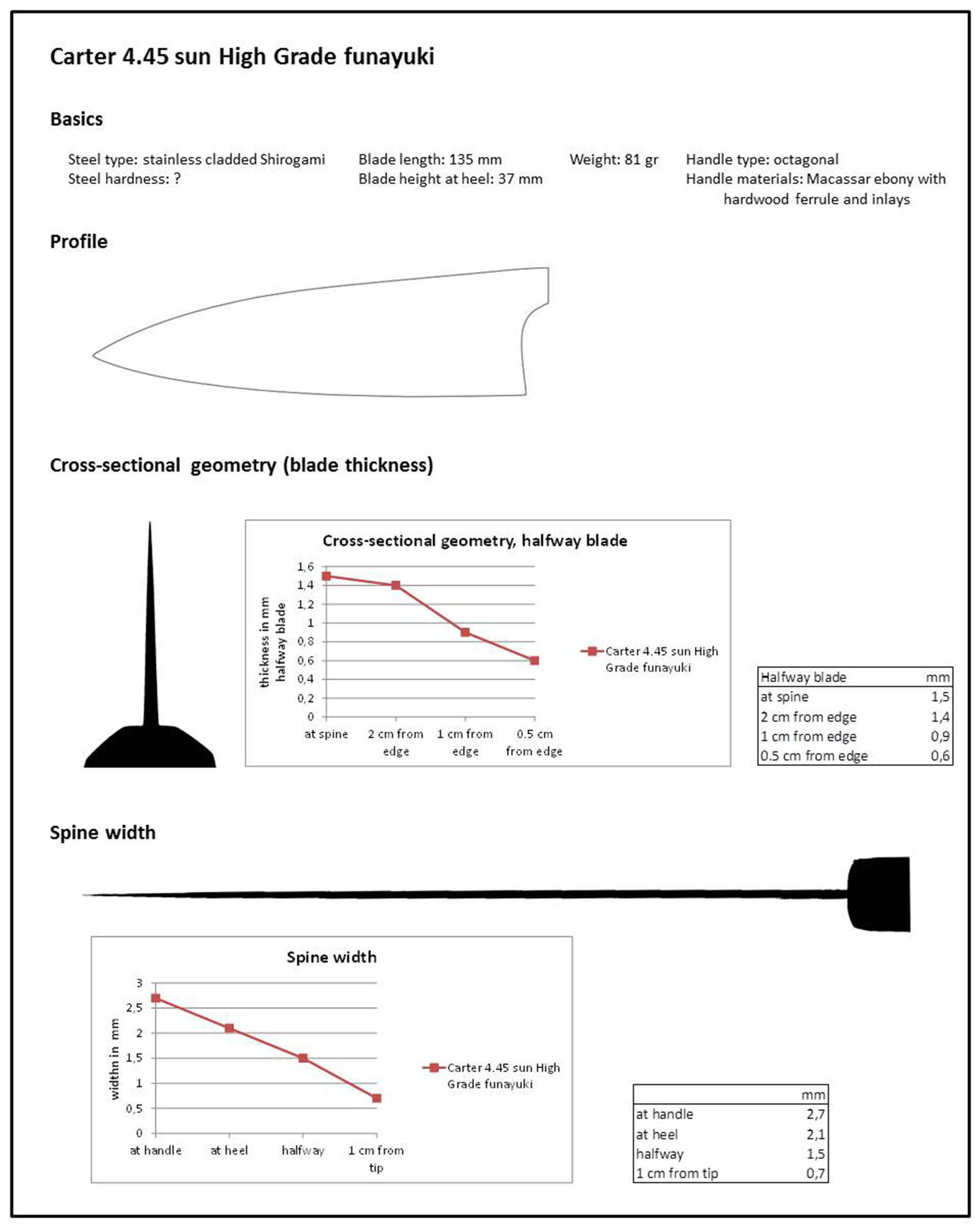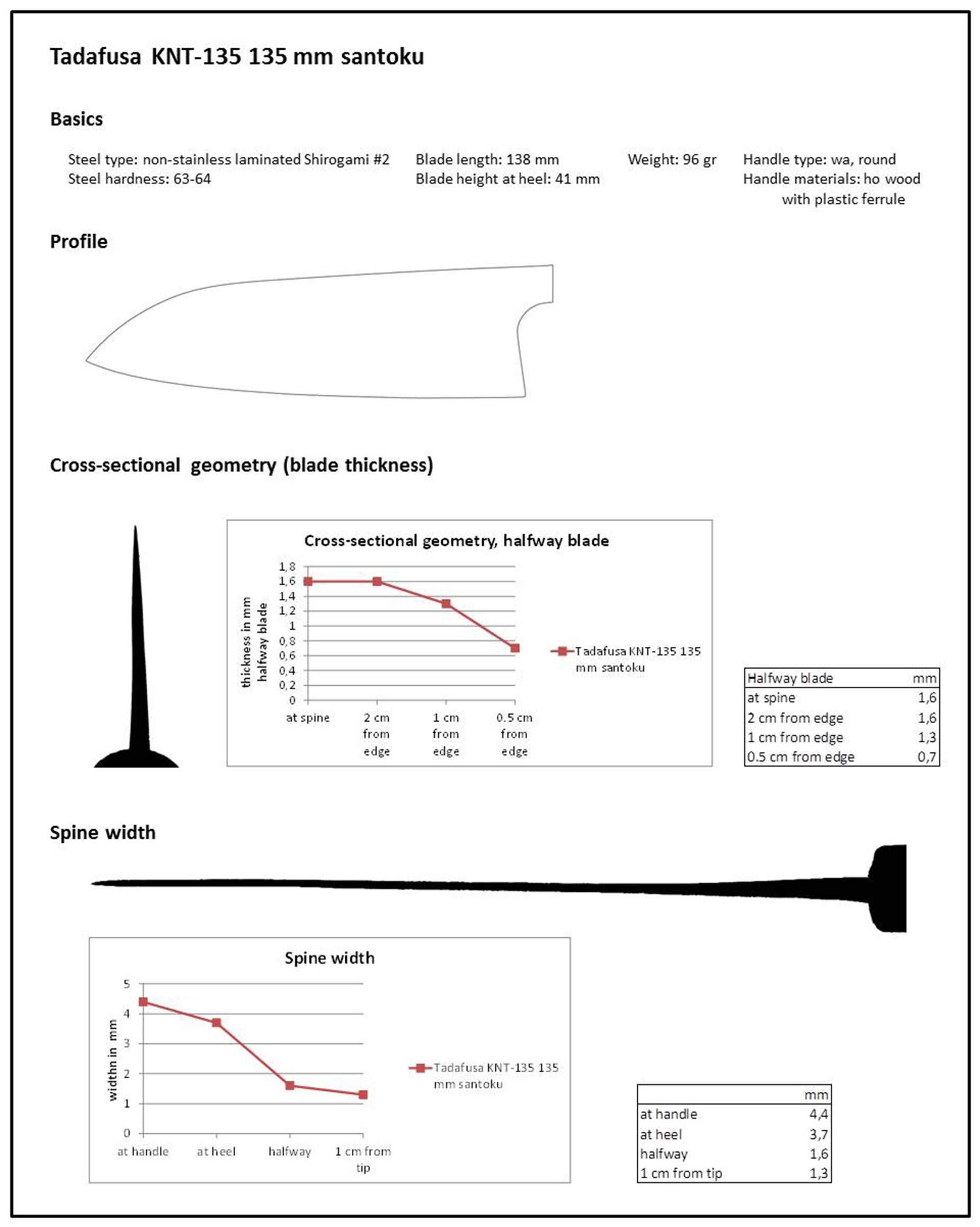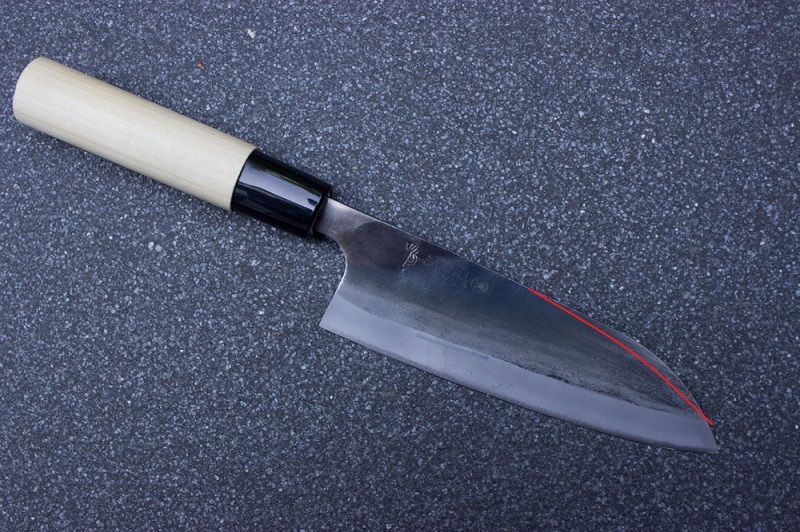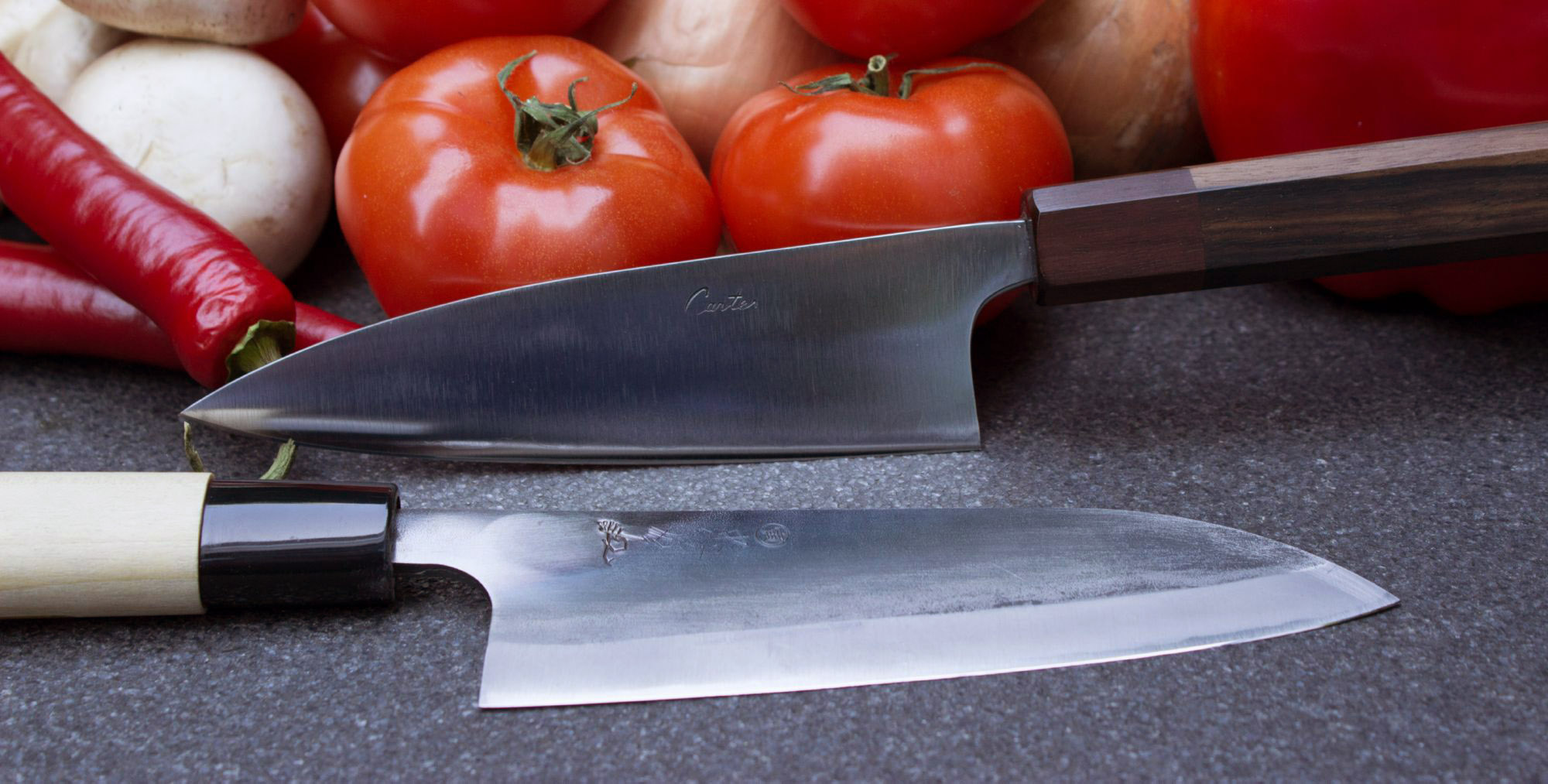
A friend of mine, who is a very good home cook, uses only one knife for ninety percent of his cutting tasks: a 12 centimeter Global santoku. He uses it for everything, from vegetables to meat and fish. And for cardboard packages. Only for, say, a large cabbage he takes his gyuto from the wall. I dont know whether it is his fear of large pointy objects or something else, but I always find it interesting to see.
So I decided to try such a small knife as well. I also thought it would be nice to compare a high-end knife to a low-end knife. I wanted to know whether a 4.45 sun Carter High Grade funayuki, for which I paid EUR 340, would perform much better than a Tadafusa KNT-135 santoku, which set me back for EUR 60.
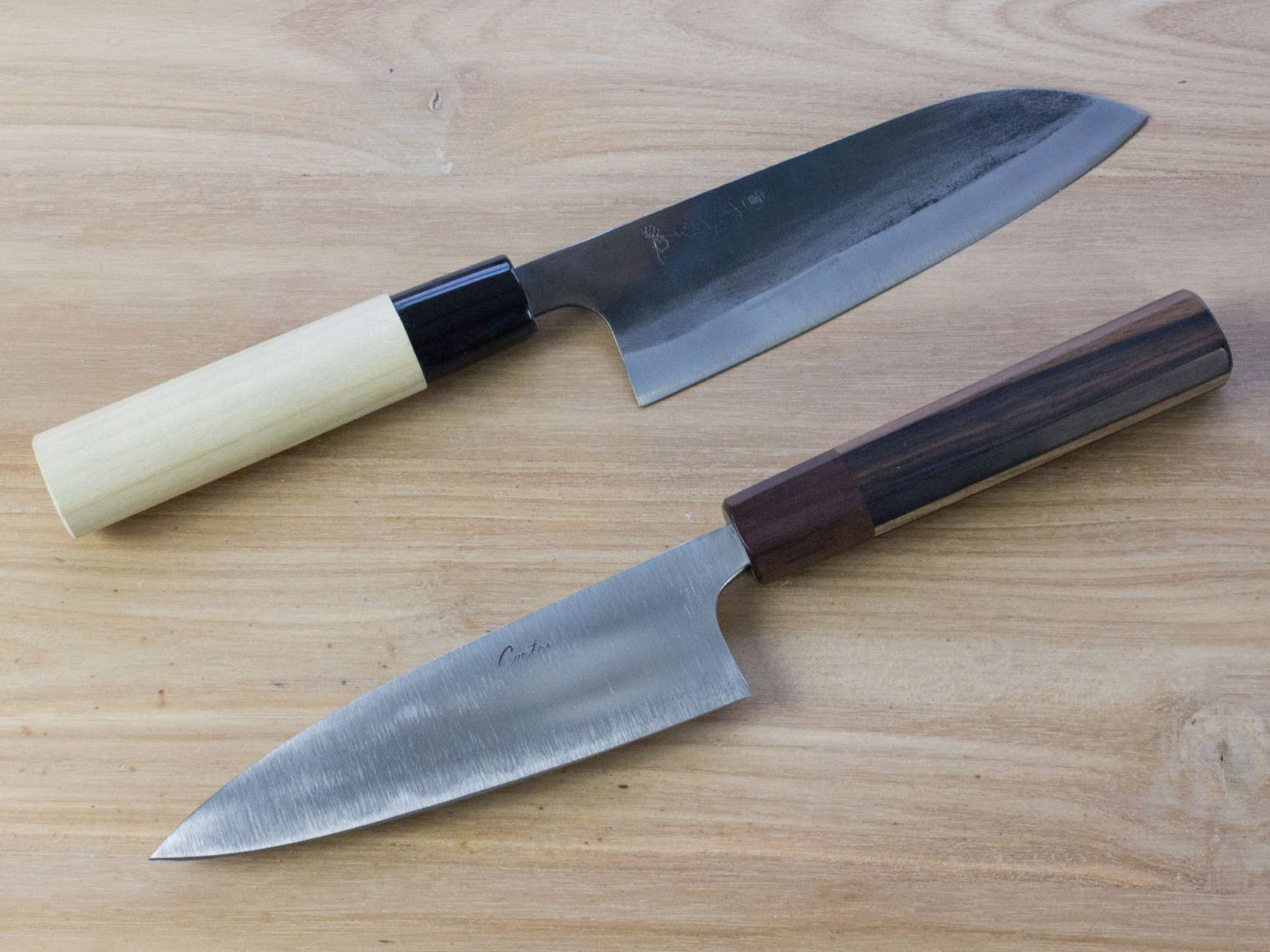
First impressions
Both knives are similar in their lengths and their shapes. The Carter measures 138 mm from tip to heel and the Tadafusa is 135 mm long. The Tadafusa is a traditional santoku with a sheep foot profile and the Carter is a funayuki, which is a bit more pointy. But there are differences, too.
The Carter is a beautiful knife with a well-polished blade and a nice handle. All of Carters High Grade knives come with individually made handles and this one is made of Macassar ebony with a hardwood ferrule and hardwood inlays. The fit and finish of this knife is impeccable.
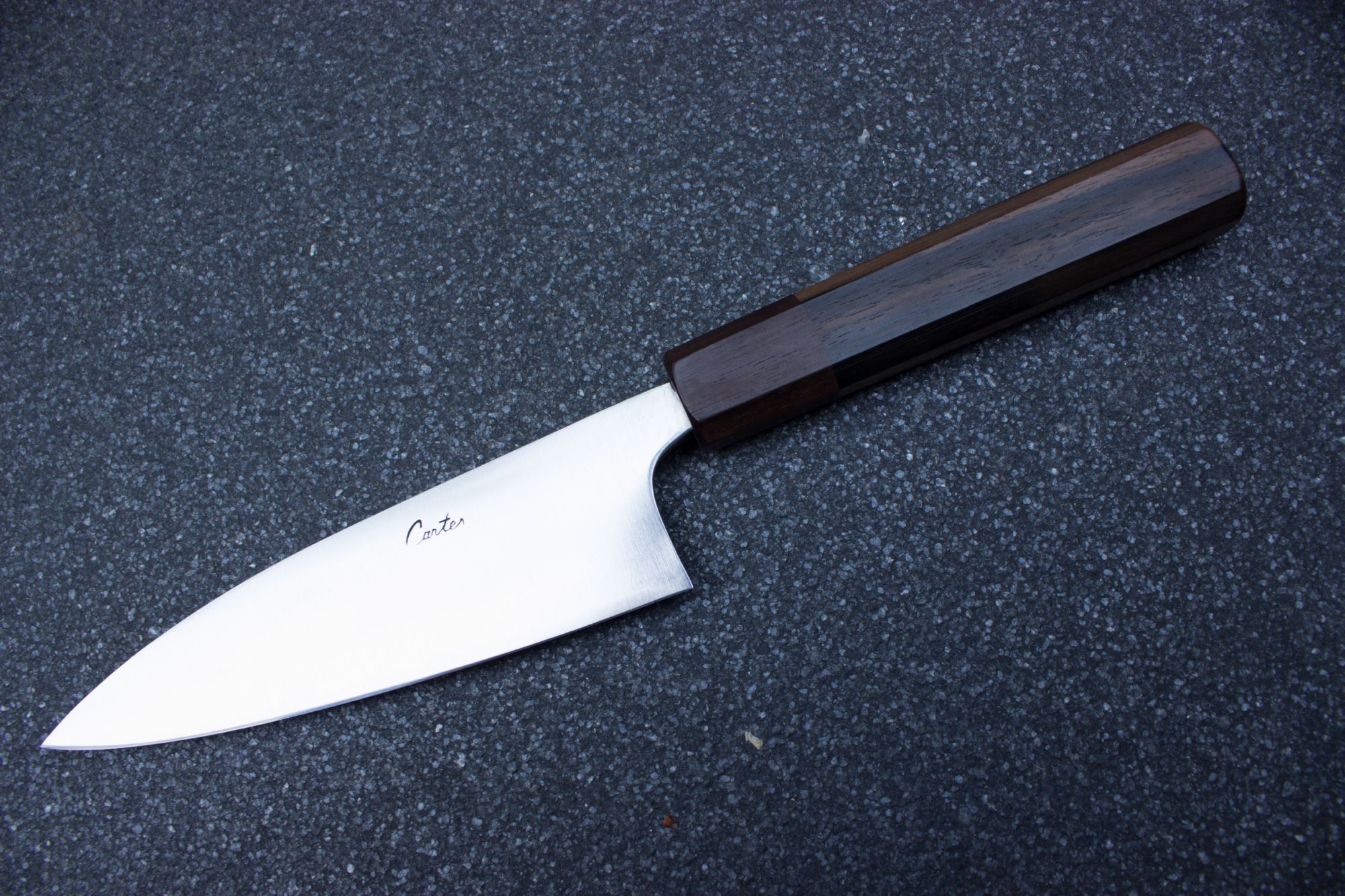
I wouldnt call the Tadafusa beautiful, but on a good day I might call it rustic. On a bad day Id say that it has a bad fit and finish. It has a ho wood handle with a plastic ferrule. The ferrule is at least one millimeter lower than the ferrule. The blade has a kurouchi finish that looks nice. However, the spine and the choil were so sharp I could only use the knife after touching them up with sandpaper.
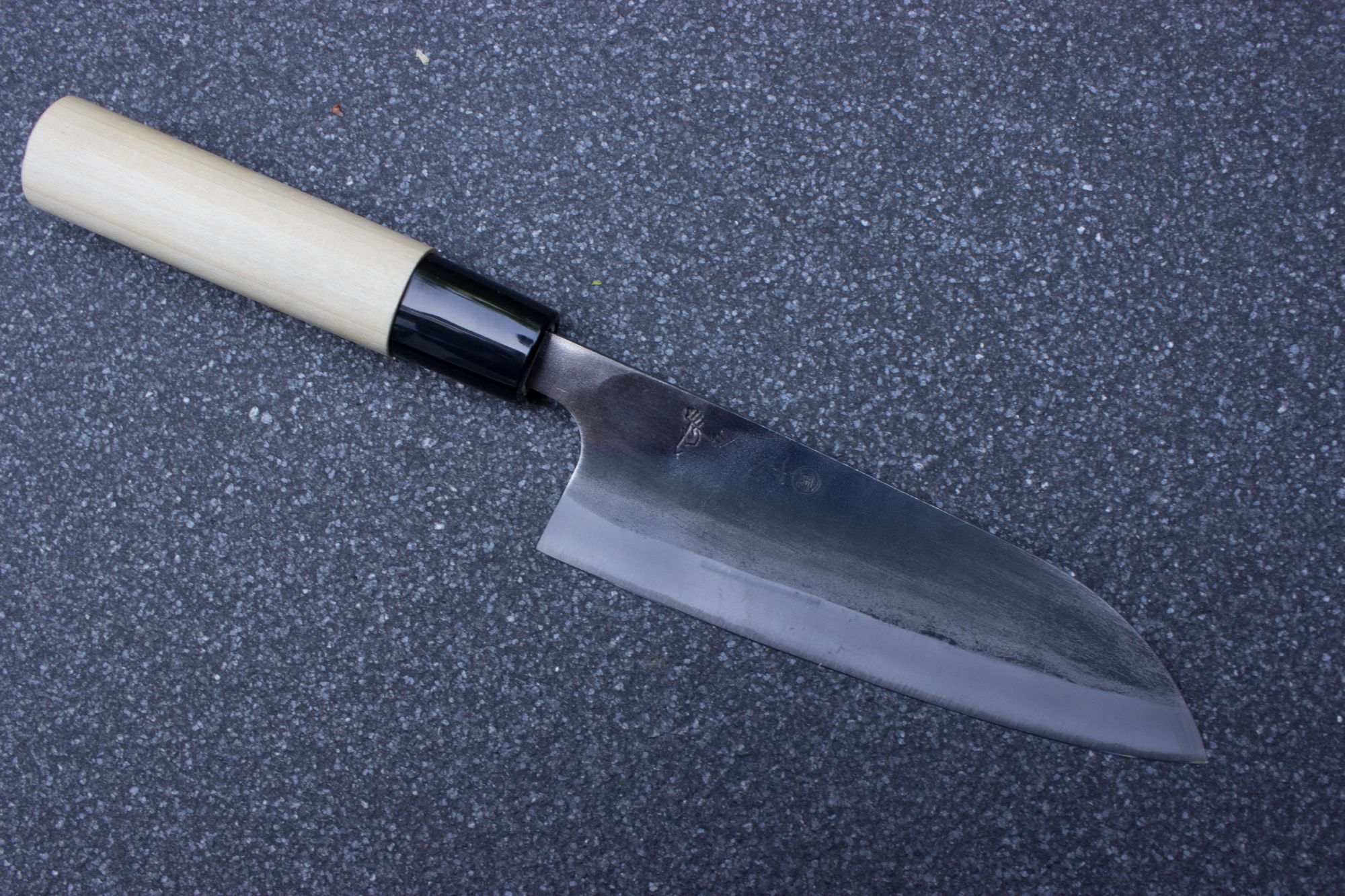
Blades
The Carter has a blade made of shirogami steel with a stainless cladding. Carter doesnt say whether it is shirogami #1 or #2. The transition from the cladding to the core steel (the hamon) is visible and a nice wavy line, but initially not very distinctive. The spine and the choil of the blade have been rounded, so the knife feels comfortable in the hand.
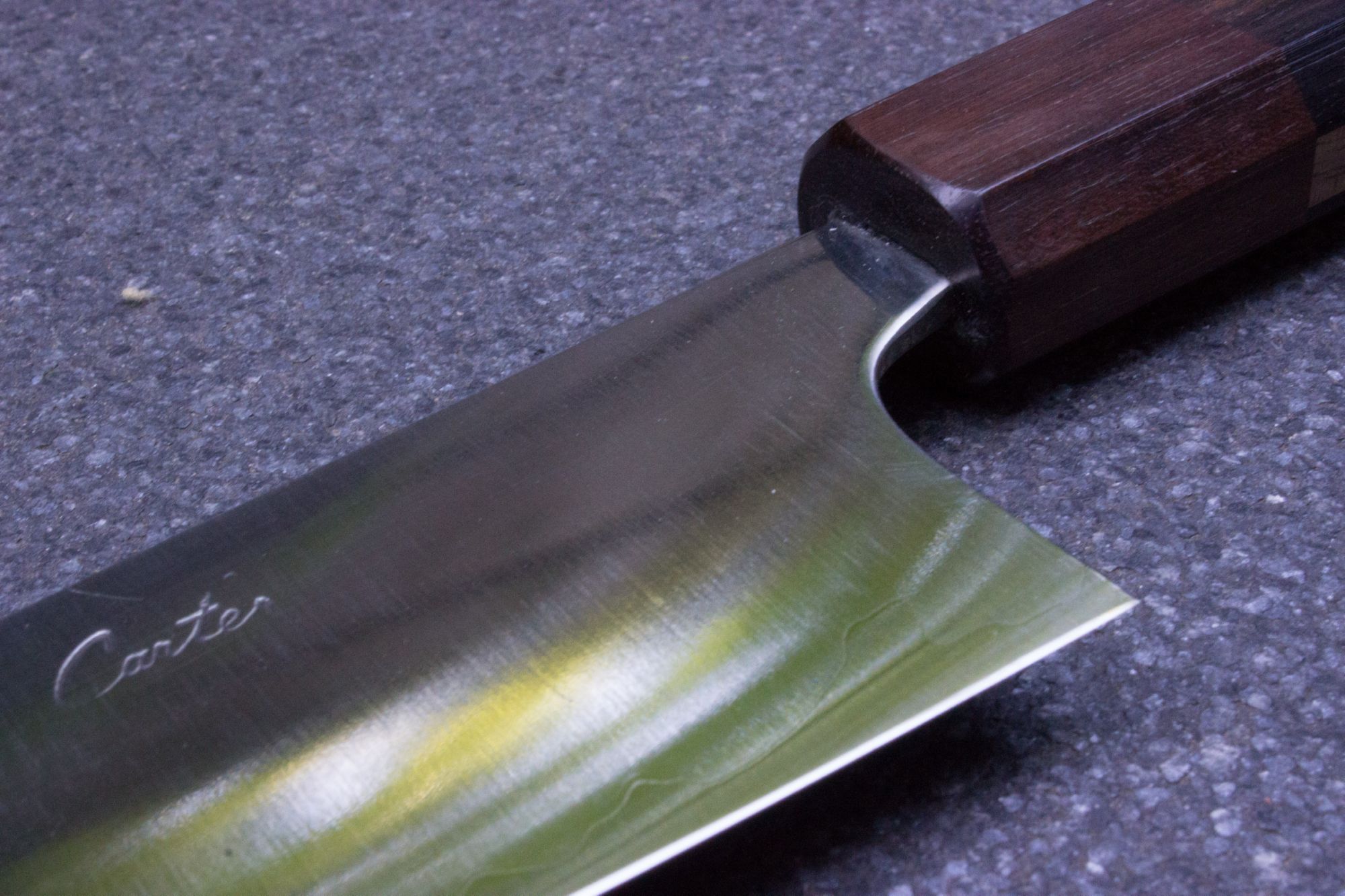
This Carter knife has the typical funayuki profile that Westerners might describe as a compromise between a gyuto and a santoku. In his book Bladesmithing with Murray Carter, Carter writes: The funayuki is a variation on the wabocho [the traditional Japanese workhorse knife], in that it has a very thin blade. The graceful isosceles-shaped blade is pointier and a little narrower in width than the wabocho. Isosceles means that two sides, in this case the spine and the edge, have the same length.

Some more interesting facts from Carter: The funayuki, literally meaning boat (ocean) going is actually a hybrid between a wabocho and a yanagi-ba. It was designed to take aboard fishing vessels where the fisherman could cut up some of the catch for immediate tasting to verify the quality of the fish. [...] Smaller funayuki blades (105-135 mm) are often used in Japan like a paring knife is used in North America.
The blade of the Carter knife has a nice taper. The spine is 2.1 mm wide at the heal and 0.7 mm wide at one centimeter from the tip.

I also like the geometry of this blade. It is very symmetrical for a hand-made knife and tapers down to the edge in a convex manner. It is thin above the edge, but not too thin.
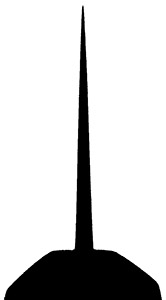
The Tadafusa has a blade made of shirogami #2 steel that is laminated with a non-stainless steel with a kurouchi layer. There are heat marks on the blade from burning the tang into the handle. I worried whether this could have impacted the heat treatment of the knife, but when I used the knife, I didnt notice this.
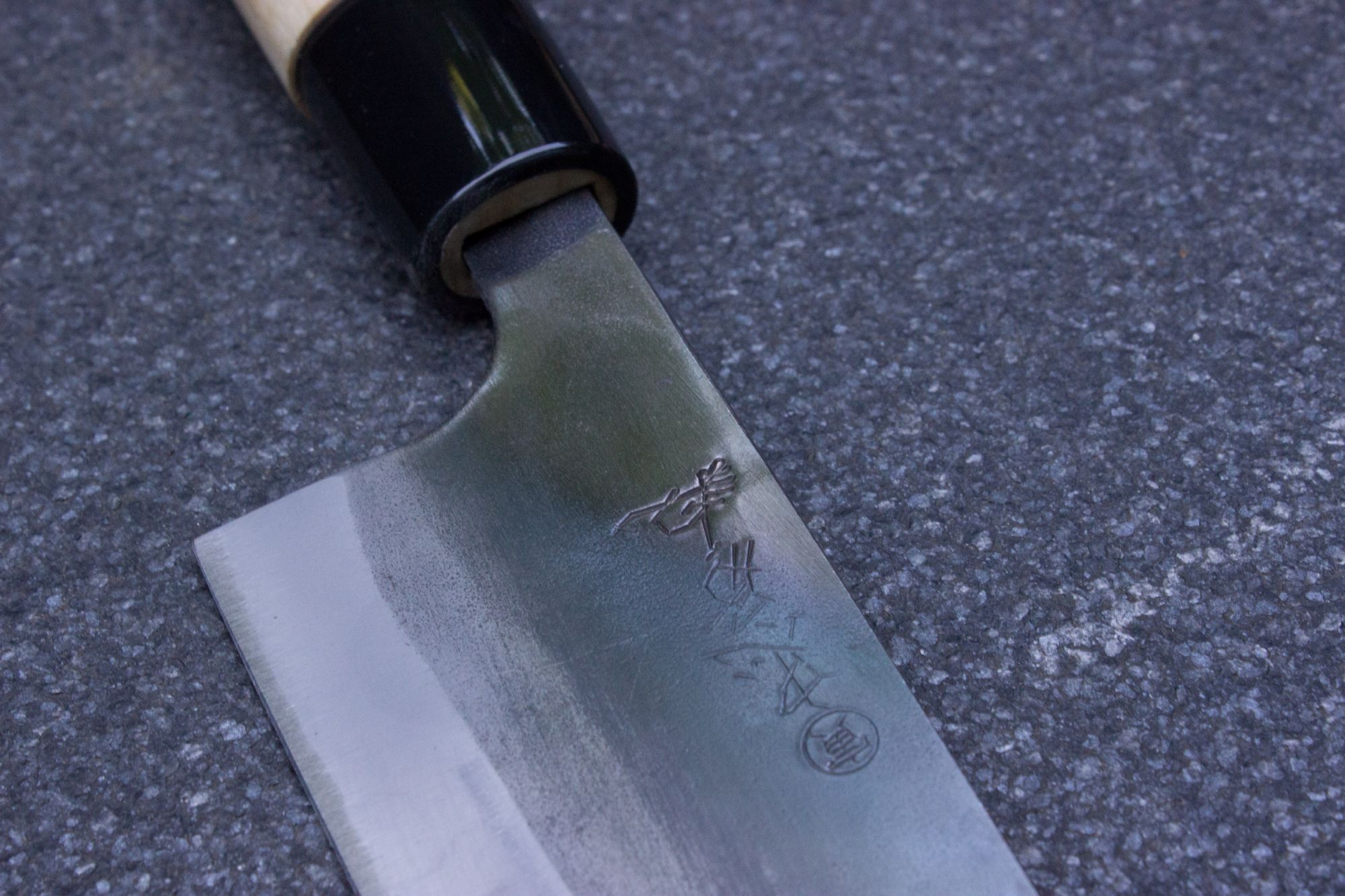
The Tadafusa has a traditional santoku profile, although it has quite a lot of belly for a santoku.

The spine of this knife is clearly not straight. It does taper from the heel to about one third of the blade, but then there is hardly any taper anymore. The spine is still 1.3 mm wide at one centimeter from the tip.

The geometry is also a bit odd. The left side of the blade (when you have the knife in your hand--right on the picture) is steep, like in a full flat grind. The right side looks like it was intended to be straight, but has some irregularities. When you are in a good mood you might call it an S-grind. The knife is thicker just above the edge than the Carter.
Use
The Carter was very sharp out of the box and not in need of any sharpening. The Tadafusa was simply blunt. In order to be able to properly compare these knives I sharpened both of them with my Chosera stones up to 5,000 grit.
Then I threw lots of things at these knives: onions, carrots, potatoes, tomatoes, bell peppers, herbs, garlic, mushrooms, meat, ...
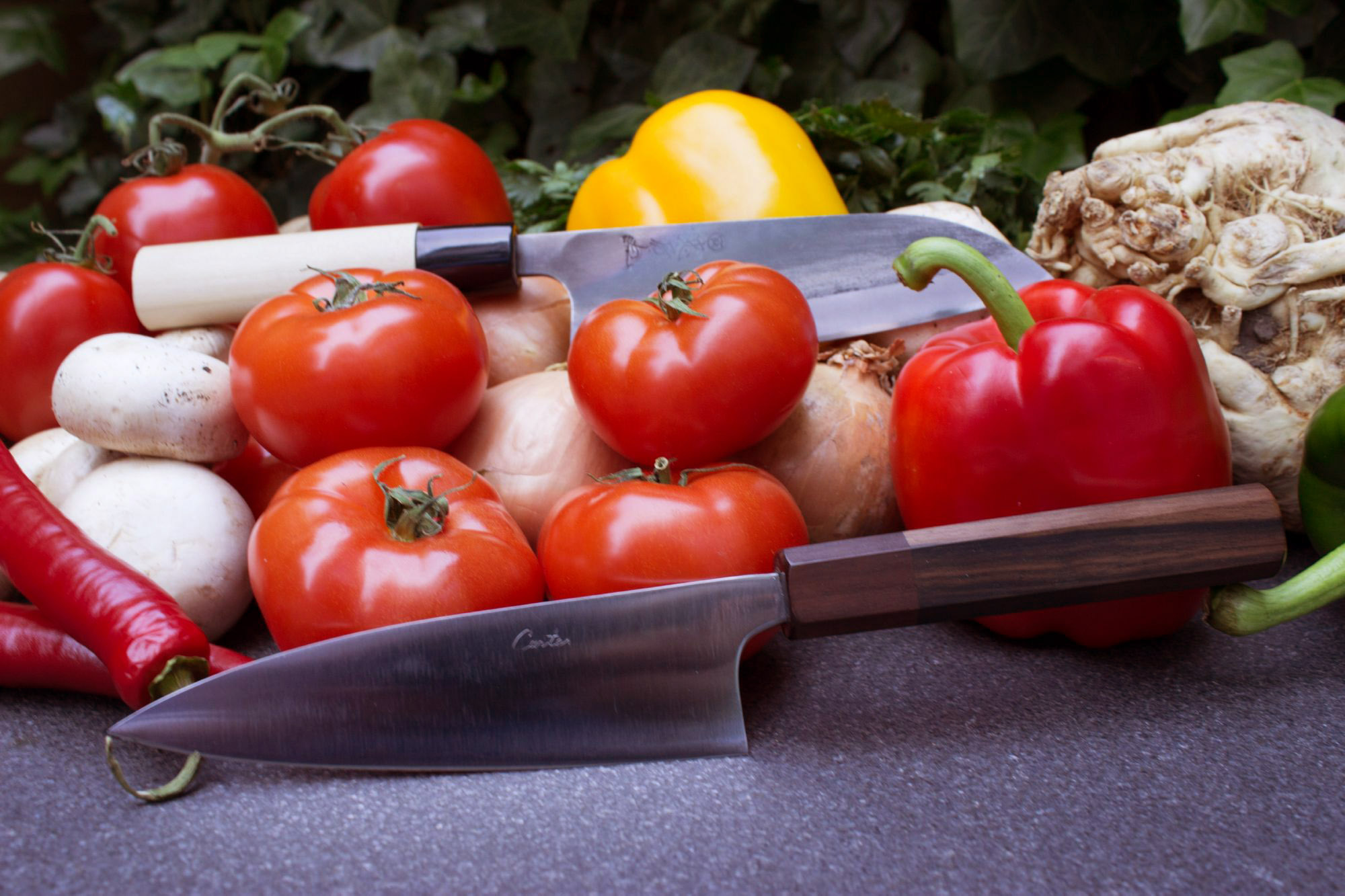
The difference between the Carter and the Tadafusa was one between day and night. The Carter flew through nearly everything. It dealt beautifully with the hard vegetables, the soft ones and the meat. The Tadafusa, however, required a lot more force to go through everything. It wedged a bit on the harder vegetables. However, the real problem was not the wedging as such, but that it simply always required more force than the Carter. Here the regular and proper forge and grind of the Carter and its better finish really paid off.
Please note that this is a comparison, so it is relative. The Tadafusa still cut better than most of the knives of the friend who got me into this comparison.
The Tadafusa was especially bad at cutting things that benefit from a thin tip, like small vegetables, garlic or onions. This particularly is a pity for the knife, because this is the purpose you would use it for most.
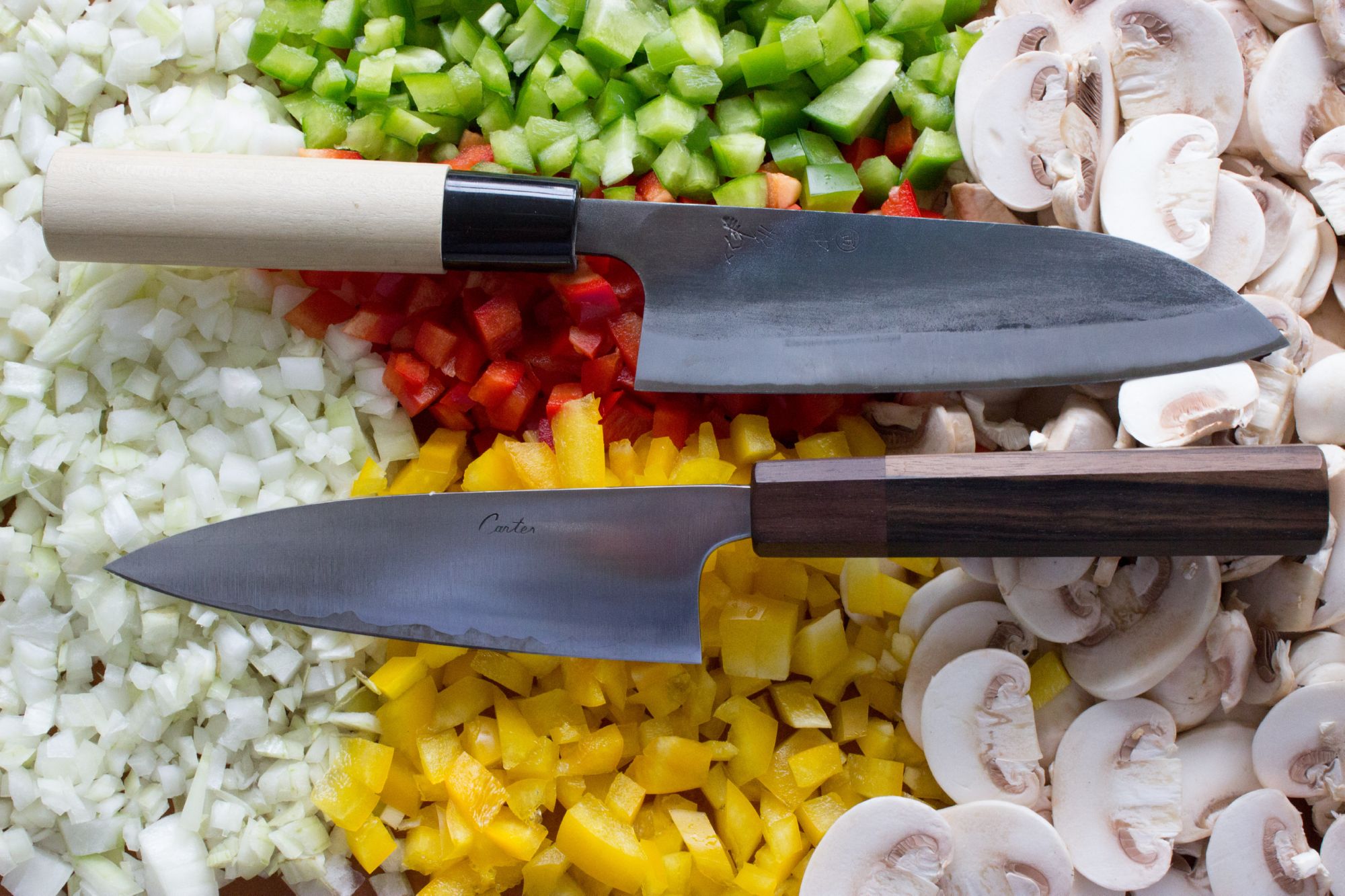
Both knives are made of shirogami steel, which is quite reactive. After only a few onions a patina already started to form on the core steel of both knives. Fortunately the claddings, including the non-stainless cladding on the Tadafusa, worked in protecting the remainder of the blades. And I didnt experience any rust, even though I did not wipe the blades after every task.
In general I liked the size and profile of both knives a lot. They have a bit more height at the heel than a paring knife or a small petty and this makes cutting things like onions or mushrooms more enjoyable to me. If you are a professional chef or anyone else for whom production it is important, a gyuto may work better. But I understand why my friend likes his small santoku so much.
Conclusion
I enjoyed the size and the profile of both knives. They make an interesting change from a paring knife or a small petty. Both knives are true general-purpose knives and suitable for all smaller things to cut.
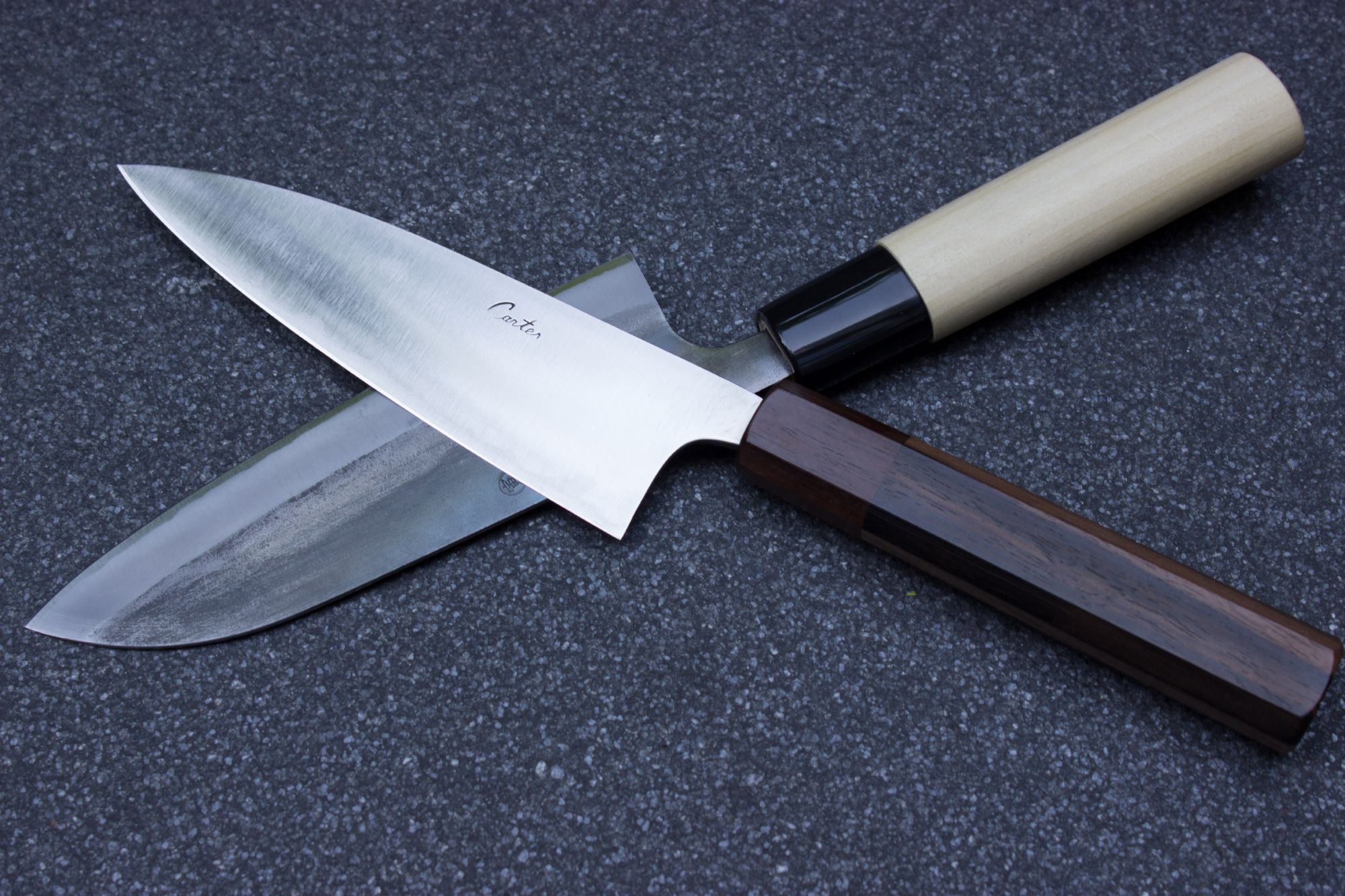
The saying you get what you pay for definitely applies to these knives. The Carter is an expensive high-end knife, and it cuts great. It also is a great looking knife with a very good fit and finish. The Tadafusa is one of the cheapest knives with shirogami steel I know. It cuts a lot less than the Carter. It is a case where bad fit and finish is not only a matter of aesthetics or ergonomics, but even impacts the cutting performance.
That said, after a little work on it, the Tadafusa would still be a nice knife for someone just starting with Japanese carbon steel knives. I have already sharpened the knife and rounded the spine and choil, so I think I will give it to a friend. The Carter stays in my house.
Factsheets
